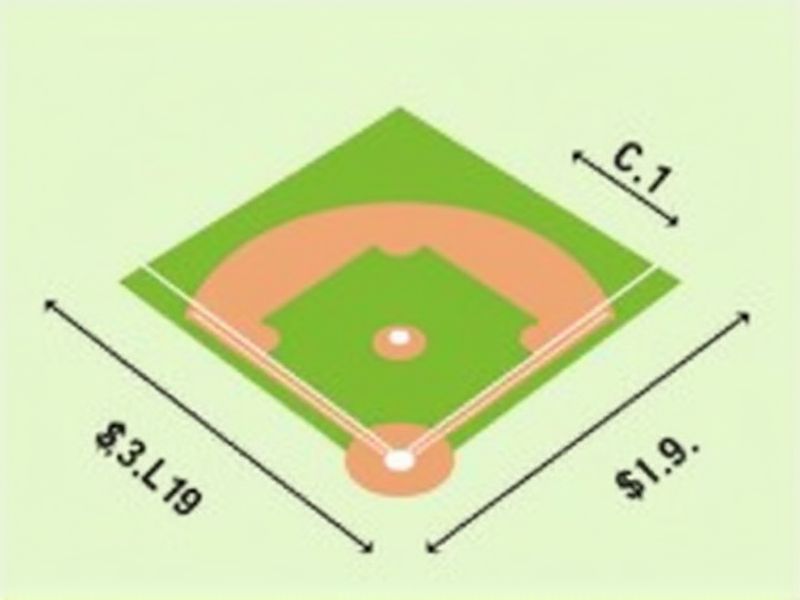
The standard dimensions of a baseball diamond are designed to keep the game fair and enjoyable for players of all skill levels. The distance between each base is 90 feet, forming a square-shaped infield, while the pitcher's mound is located 60 feet, 6 inches from home plate. Outfield fences vary depending on the ballpark, but typically range between 300 and 410 feet from home plate. Knowing these measurements helps ensure that any baseball field you set up or play on meets the traditional standards used in organized leagues.
Distance Between Bases
The standard distance between bases in a baseball diamond is 90 feet (27.43 meters), forming a crucial part of the game's layout. This measurement ensures a balanced challenge for players, allowing for strategic play and competitive dynamics. The pitcher's mound is positioned 60 feet 6 inches (18.44 meters) from home plate, contributing to the overall geometry of the field. Understanding these specific distances enhances your appreciation of the intricacies involved in baseball strategy and player performance.
Pitcher'S Mound To Home Plate
The regulation distance from the pitcher's mound to home plate in Major League Baseball is 60 feet, 6 inches, making it critical for pitchers to develop precise throwing techniques. The pitcher's mound itself is raised 10 inches above the level of home plate and measures 18 feet in diameter. This specific elevation aids in enhancing pitch trajectory and deception, contributing to the strategic dynamics of the game. Proper understanding of this layout is essential for players, coaches, and enthusiasts to appreciate the challenges and skills involved in baseball.
Base Path
A standard baseball diamond features a base path of 90 feet between each of the four bases: home plate, first base, second base, and third base. The infield is bordered by a dirt area that extends approximately 90 feet from home plate to the pitcher's mound, where the mound rises 10 inches. The foul lines extend to the outfield fences, often between 300 to 400 feet from home plate, creating a playable area that can vary in dimensions. Understanding these measurements is crucial for players and coaches to optimize performance and strategy during the game.
Home Plate Size
The dimensions of a baseball home plate are critical for the game's integrity, measuring 17 inches wide and 8.5 inches deep. Its uniquely pentagonal shape aids pitchers in achieving precision with every throw, as the corners of the plate extend to 12 inches in width at the back. Home plate is positioned 90 feet away from each base, making it central to the 90-foot diamond layout. Understanding these specifications can enhance your appreciation of the strategic elements involved in gameplay.
Infield Arc Radius
The standard baseball diamond features an infield arc radius of 95 feet, ensuring a uniform playing surface and optimal performance. This measurement is critical for maintaining consistent fielding and pitching dynamics, particularly for positions like shortstop and pitcher. In professional leagues, the entire infield layout adheres to the Official Baseball Rules, which specify dimensions for bases and the pitcher's mound. Understanding these specifications can enhance your appreciation for the game's strategic intricacies and the skills required for success on the diamond.
Batter'S Box Dimensions
The batter's box in baseball is precisely defined, measuring 4 feet wide and 6 feet long, with its back edge set 6 inches from the rear of home plate. This configuration ensures the batter has adequate space to stand and swing at pitches, promoting fair play and safety. The dimensions are consistent across all levels of the game, ensuring uniformity from youth leagues to Major League Baseball. Proper adherence to these specifications enhances your overall hitting experience, allowing you to optimize your stance and approach at the plate.
Catcher'S Box Dimensions
The catcher's box in a baseball diamond measures 43.5 inches wide by 8.5 feet long, positioned directly behind home plate. This area is crucial for a catcher, as it defines the legal positioning for receiving pitches and managing base runners. Maintaining these dimensions ensures that the catcher has adequate space to maneuver without interfering with the batter, facilitating smooth gameplay. Understanding these specifications can enhance your appreciation for the sport's intricacies.
Coach'S Box Location
The coach's box in baseball is strategically positioned along the first and third baselines, typically extending 10 feet in width and 6 feet in depth. This area is vital for coaches to effectively communicate with players during games, allowing for clear signals and instructions. In accordance with MLB regulations, the coach's box must be located within 10 feet of the baseline and no more than 15 feet from the foul line. Proper adherence to this standard ensures a smooth flow of play and enhances your team's strategic management on the field.
Foul Lines Length
In baseball, the foul lines extend from home plate to the outfield fence, measuring 325 feet to the foul pole in most standard parks. Each line is crucial for determining fair and foul balls during gameplay, influencing strategic decisions made by players and coaches. The distance helps maintain the integrity of the game, especially when assessing hits or determining home runs. Understanding the dimensions of the foul lines can enhance your appreciation for the strategy involved in baseball.
Outfield Fence Distance
In professional baseball, the outfield fence distance is a critical aspect, typically ranging from 325 to 400 feet from home plate, depending on the stadium's design. Major League Baseball (MLB) requires each park to provide specifications that ensure fair play while accommodating unique characteristics. For instance, center field is often the farthest point, averaging around 400 feet, which challenges players' hitting and fielding abilities. Understanding these distances can enhance your viewing experience, as they significantly influence game strategy and player performance.
